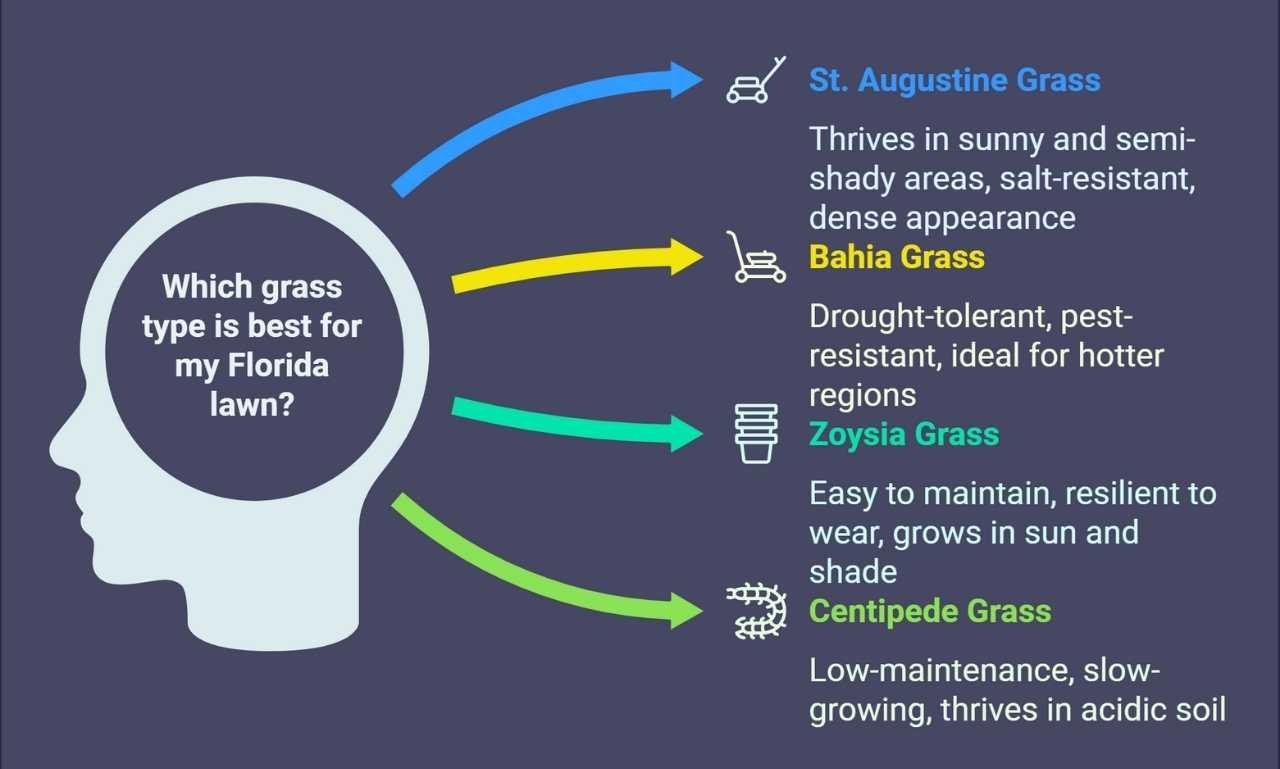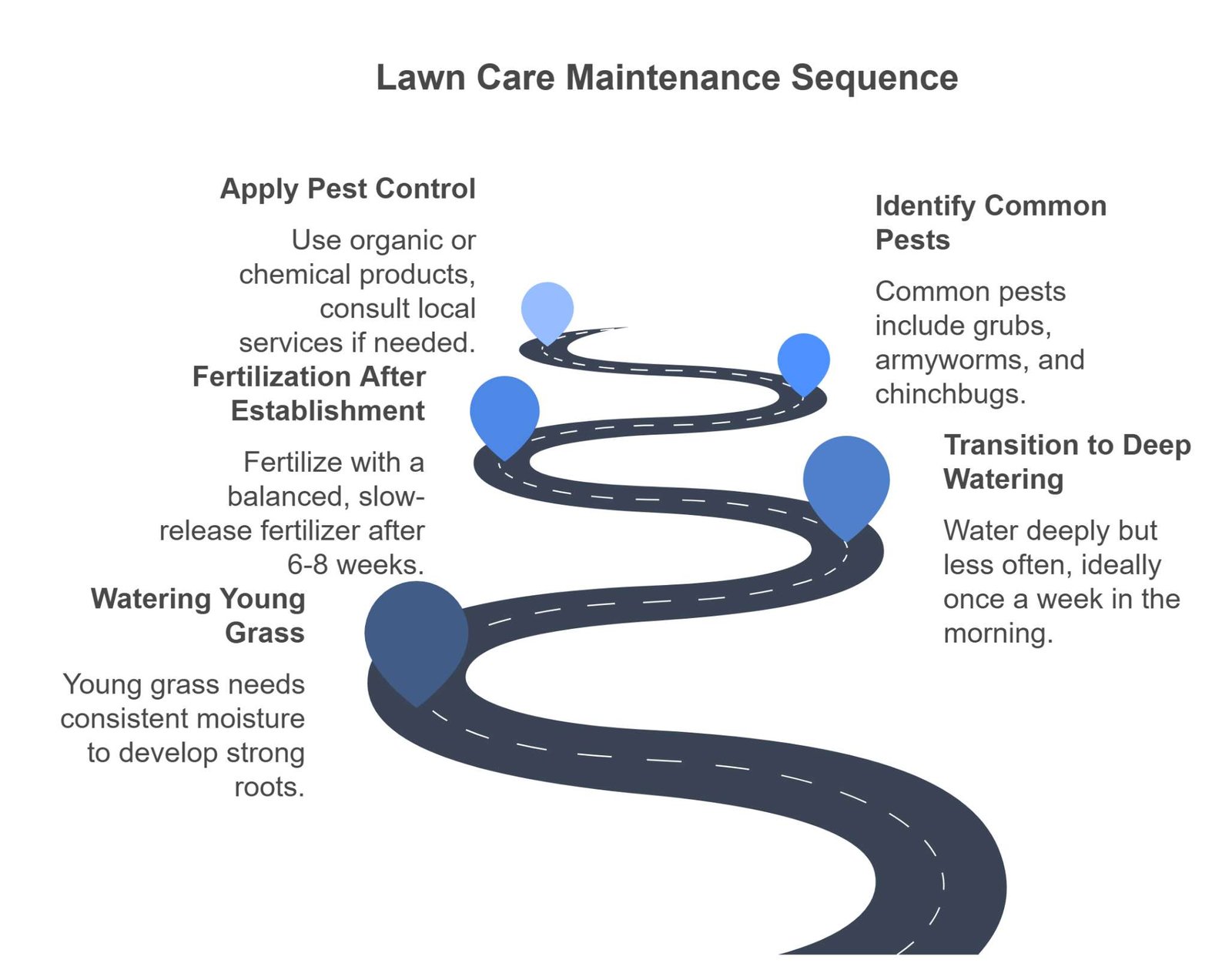Growing grass from seed in Florida can transform your outdoor space into a lush, green oasis. However, the subtropical climate presents unique challenges and opportunities that every homeowner should understand. Whether you’re looking to create a vibrant lawn for family gatherings, a safe play area for children and pets, or simply to enhance your home’s curb appeal, knowing how to successfully establish grass from seed is essential. In Florida, the warm climate allows for a variety of grass types to thrive, but timing and preparation are crucial. The best time to sow your seeds typically falls between April and July, allowing your grass to establish before the cooler months set in. This guide will walk you through the essential steps—from selecting the right type of grass seed suited for Florida’s conditions to preparing your soil and ensuring proper care during the critical germination period.

Best Grass Types for Florida
Choosing the right type of grass is the first crucial step in planting a thriving lawn in Florida. Given the state’s varied climate zones, certain grass types perform better than others. Here’s a breakdown of the best grass varieties suited for Florida lawns:
- St. Augustine Grass: Known for its ability to thrive in sunny and semi-shady areas, St. Augustine is a popular choice for Florida lawns. It’s highly salt-resistant, ideal for coastal areas, and provides a dense, lush appearance.
- Bahia Grass: Bahia grass is drought-tolerant and highly resistant to pests. It is a fantastic choice for Florida’s hotter regions. It’s particularly well-suited for rural areas with lower maintenance needs, though it can be coarse in texture.
- Zoysia Grass: Zoysia is an excellent choice for homeowners seeking a lawn that’s easy to maintain and resilient to wear and tear. Zoysia grows well in both sun and partial shade, making it versatile for various environments.
- Centipede Grass: Centipede grass is ideal for homeowners looking for a low-maintenance option. It’s slow-growing, less labor-intensive, and thrives in Florida’s acidic soil.
Choosing the Right Grass for Your Lawn
When selecting a grass type, consider the following factors:
- Soil Type: Sandy soils, common in Florida, may require more water and nutrients. Bahia and Zoysia grass are typically more drought-tolerant and better suited for these conditions.
- Climate: St. Augustine is often the best choice for southern regions due to its heat tolerance. Zoysia and Centipede are ideal in northern Florida as they can better handle cooler temperatures.
Local Tip: Homeowners in Miami and Tampa may prefer St. Augustine because it can handle saltwater and humidity. At the same time, those in Orlando or Jacksonville could lean toward Zoysia because of its resilience to fluctuating temperatures.
How to Prepare Your Lawn for Grass Seed
Before planting your grass seed, Proper preparation is crucial for ensuring successful germination and growth. Follow these steps to get your lawn ready:
1.Test Your Soil
Florida’s soil can vary greatly, from sandy to clay-like, affecting grass growth. Testing your soil helps you understand its pH and nutrient levels. The ideal pH level for most grass types is between 6.0 and 7.0.
2.Add Nutrients and Amendments
According to your soil test results, you may need to add amendments such as:
- Compost: Enhances soil structure and increases nutrient availability.
- Lime: Raises pH in acidic soils, which is often the case in Florida.
- Fertilizer: A slow-release fertilizer will provide essential nutrients for young grass seedlings.
3.Level and Prepare the Ground
Ensure the ground is level to prevent water from pooling in low areas. Rake the soil to break up clumps and remove debris like rocks or dead grass.
4.Sod vs. Seed
While sod can provide instant coverage, grass seed is a more affordable and flexible option for homeowners who are patient enough to wait for the grass to grow. If you’re going the seed route, ensure the seed is evenly spread across the lawn to avoid patchy growth.
When and How to Plant Grass Seed
Timing is key when planting grass in Florida. The best time to plant grass seed is from late winter to early spring when temperatures are ideally between 65°F and 75°F. This is the optimal time for grass seeds to germinate and establish roots before the intense Florida heat sets in.
Step-by-Step Planting Guide:
- Prepare the Seed Bed: Once you’ve prepped the soil, use a rake or garden spreader to distribute the grass seed evenly.
- Sow the Seed: Sow the seed by hand for smaller areas to ensure even coverage. For more extensive lawns, use a broadcast spreader.
- Watering: Water the newly seeded lawn right after planting, ensuring the soil remains moist but not waterlogged. Keep the lawn consistently moist until the seeds germinate, typically taking about 7 to 14 days.
- Depth: Ensure the seeds are not planted too deep. A thin layer of soil or light raking will help cover the seed, making it easier for the roots to establish.
Visual Tip: Consider using a garden roller to press the seeds into the soil for better contact, which will lead to faster germination.
Ongoing Care for a Healthy Lawn
Once your grass has sprouted, it’s crucial to continue caring for your new lawn to ensure it thrives. Here’s how:
Watering
Young grass needs consistent moisture to develop strong roots. During the first few weeks, water your lawn lightly and frequently (every 1-2 days). After the grass is established, water deeply but less often, ideally once a week in the morning.
Fertilization
After your new grass has been established for about 6-8 weeks, fertilize it with a balanced fertilizer. Opt for slow-release formulas designed for Florida lawns.
Pest Control
Florida’s warm, humid climate makes it a hotspot for pests. Common lawn pests include grubs, armyworms, and chinchbugs. Use organic or chemical pest control products to protect your lawn, and consider consulting a local pest control company if infestations occur.
Local Success Story: John, a homeowner in Miami, successfully grew a lush St. Augustine lawn by regularly watering during the dry season and using a local pest control service to combat chinch bugs.

Troubleshooting Common Problems
Even with the best care, you may encounter a few issues. Here’s how to address common problems:
1.Patchy Growth
If your grass grows unevenly, it could be due to improper seed distribution or watering. Reseed any bare patches and ensure even watering.
2.Poor Germination
Poor germination may be caused by overly dry conditions, excessive heat, or deep planting. Ensure consistent moisture and plant at the recommended depth.
3.Weed Invasion
Weeds can choke out your new grass. Apply pre-emergent herbicides before planting, and regularly remove any weeds manually or with an organic weed killer.
FAQs for Seeding Grass in Florida
1. What are the best types of grass seeds for Florida lawns?
Florida’s climate is hot and humid, which means warm-season grass varieties perform best. Some popular choices include:
- St. Augustine grass: Ideal for shaded areas and high traffic.
- Bermudagrass: Great for sunny, open spaces with excellent drought tolerance.
- Zoysia grass: Versatile and grows well in both sun and shade.
- Centipede grass: Low maintenance and thrives in acidic soils.
2. How do I prepare my soil for seeding grass in Florida?
Preparing soil is critical to ensure successful grass growth. Here’s what to do:
- Test your soil: Check pH levels and nutrient content using a soil testing kit. Florida soils often need amendments to balance pH.
- Clear the area: Remove weeds, rocks, and debris.
- Loosen the soil: Use a tiller to break up compacted soil to a depth of 4-6 inches.
- Add amendments: Incorporate compost, organic matter, or lime as recommended by the soil test.
- Level the ground: Smooth the area to prevent water pooling.
3. What are the common mistakes to avoid when seeding grass in Florida?
Avoid these common pitfalls:
- Using the wrong grass seed: Choose a variety suited for Florida’s climate and your lawn’s specific conditions (sun, shade, or traffic).
- Not preparing the soil properly: Skipping soil testing or amendments can lead to poor germination.
- Overseeding: Applying too much seed can lead to overcrowding and weak growth.
- Inconsistent watering: Newly seeded grass needs regular, light watering to thrive.
- Seeding during the wrong season: Avoid seeding during extreme heat or cold.
4. How often should I water newly seeded grass in Florida?
For newly seeded grass, consistent moisture is key:
- Water lightly 2-3 times a day during the first two weeks to keep the topsoil moist.
- Once the grass starts sprouting (around 2-3 weeks), reduce watering to once a day.
- After the grass is established (4-6 weeks), transition to a deeper watering schedule of 2-3 times per week.
5. Can I plant grass seeds in Florida during the winter?
Yes, but it depends on the grass type.
- Warm-season grasses like St. Augustine and Bermuda grow best during spring and summer when soil temperatures are above 65°F. Winter planting may delay germination.
- If you must plant in winter, opt for cool-season grasses like Ryegrass as a temporary solution, but note these may not thrive year-round in Florida’s climate.
Conclusion
Growing grass from seed in Florida may take some effort, but the results are well worth it. You’ll be rewarded with a lush, green lawn perfect for Florida’s unique climate by choosing the right grass, properly preparing your lawn, and providing ongoing care.
Remember, the key steps are:
- Choose the best grass for Florida
- Prepare your soil correctly
- Plant at the right time and follow proper techniques
- Care for your lawn through watering, fertilizing, and pest control
Ready to start growing your dream lawn in Florida? Download our free lawn care checklist to help you stay on track, or subscribe to our monthly newsletter for more expert lawn care tips. And if you need local lawn care products or services, check out our recommended partners to help you achieve the perfect lawn!


